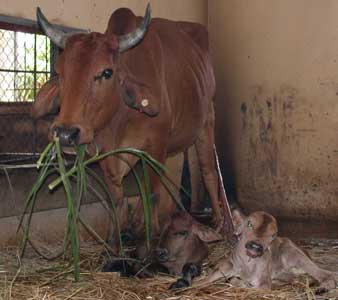 |
|
Identifying the Gender of Twin Calves from Selected Embryos Before Implantation |
Experts from the Institute of Biotechnology (Vietnam Academy of Science and Technology) have recently perfected a technology for determining the gender of embryos to produce high-quality dairy cattle in Vietnam.
This is a key project at the institute, led by Dr. Bui Xuan Nguyen, Head of the Reproductive Biology and Development Department. The goal is to rapidly create many economically efficient herds of commercial cattle at lower costs, thereby reducing the reliance on imported cattle.
According to Dr. Nguyen, to determine the gender of high-quality dairy cattle embryos, it is first necessary to isolate 5-10 cells from embryos that are 5-6 days old. Following this, the Polymerase Chain Reaction (PCR) technique is employed to amplify specific gender-related gene segments, allowing for the identification of whether the embryo is male or female.
The survival rate of embryos after the micro-surgery for cell extraction is nearly 100%.
Ultimately, the female embryos are used for implantation into Laisind cows, a breed that is relatively common in Vietnam.
 |
|
The black-colored calf in Cu Chi (2005) was produced by fertilizing the eggs of high-quality American dairy cows with semen from tropical-adapted dairy bulls. |
Before embryo implantation, experts must stimulate and synchronize the estrous cycle in the recipient cows, ensuring that the uterine environment is suitable for the age of the embryo.
To date, the team has tested this selective embryo implantation model on nearly 200 cows in Vinh Phuc, Cu Chi, and Dong Nai. For the optimized model, the calving rate of the cows reaches 50-55%.
Dr. Nguyen stated that in order to implement gender determination technology, the team first had to perfect in vitro fertilization technology to create high-quality dairy cattle embryos.
They use semen from tropical-adapted dairy bulls to fertilize the eggs of high-quality American dairy cows. These embryos will develop into tropical-adapted dairy cattle, producing 7,000-10,000 liters of milk per cycle.
The gender selection and in vitro fertilization techniques have also been employed to create high-yield meat cattle embryos adapted to tropical conditions.
According to Dr. Nguyen, the team hopes to receive support to widely apply these techniques on a large scale, contributing to poverty alleviation for farmers.


















































